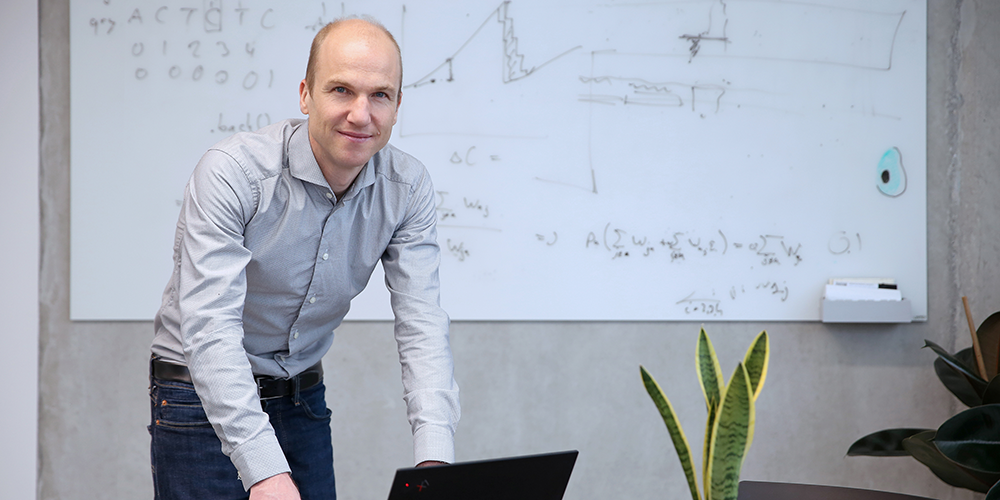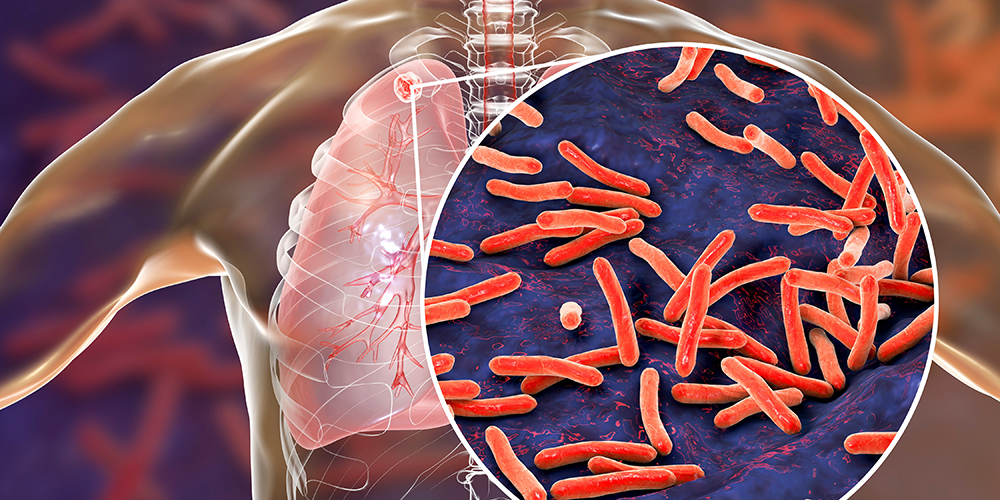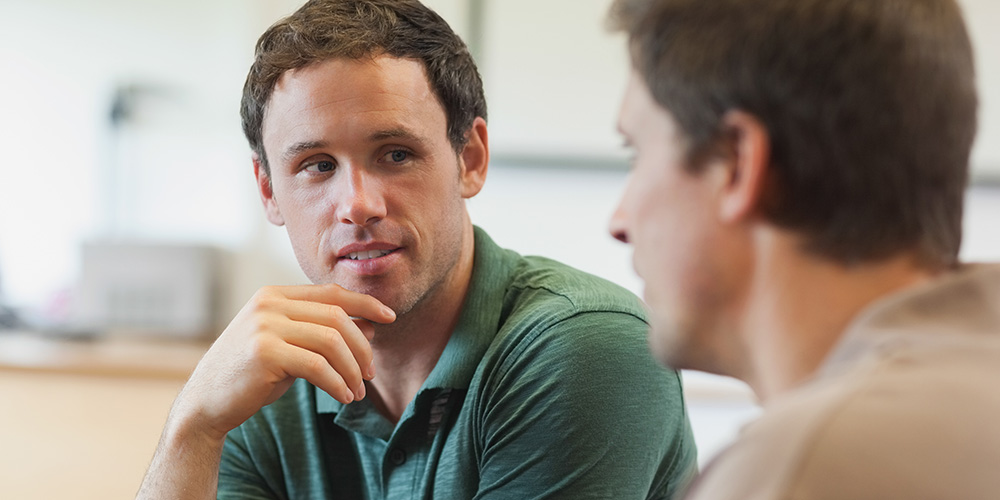“The fall wave has already started”
How is the outlook regarding Covid-19 for the coming weeks? Professor Richard Neher at the Biozentrum, University of Basel, who has been studying the evolution of the virus since the pandemic started, answers some pressing questions.
04 October 2022 | Heike Sacher
Mr. Neher, this is our first interview without masks since the beginning of the pandemic. Will this remain so?
Richard Neher: If the number of cases increases, wearing face masks again in some settings makes sense. This not only prevents infection with SARS-CoV-2 but also reduces the risk of catching the flu. And we expected that we see more cases in fall.
How many variants of the coronavirus are currently circulating worldwide? And how many of them are you following with Nextstrain?
There are very many, often rare, variants of SARS-CoV-2. And many may not have been sequenced at all. We thus don’t know how many there are. We are currently following several dozens. Our main focus lies on the various variants of the Omicron family, in particular sub-variants of BA.2 and BA.5.
Why especially these two?
BA.5 was the dominant variant here in the summer and led to a high number of infections. It displaced the BA.2 variant, which was dominant in spring. South Asia, however, has not seen much BA.5 and circulation there was dominated by BA.2. Both BA.2 and BA.5 have since evolved further to form many subvariants, some of which are not as readily recognized by antibodies. These have the potential to start a new wave. Other variants, such as BA.1 or Delta are only observed sporadically.
What variants are we facing in the fall
Currently, the lineages of highest concern are BA.2.75.2 and BQ1.1. The former has evolved away from the original BA.2 variant and picked up mutations at positions that are important for antibody binding. Recent data suggest that it can evade the immune response in humans who have had a BA.5 infection in recent months. Also, BQ.1.1, a subvariant of BA.5, has evolved in a similar way to BA.2.75.2 and is less well recognized by antibodies. Both are still rare at the moment but the number of cases is increasing.
Does that mean back to square one for us?
No, there is no going back to square one. By now, almost everyone has been vaccinated or been infected with the virus and there are hardly any immunologically naive people left. This immunity does not protect fully from infection but our immune system can react much faster with an appropriate response to an infection and fight the virus. This makes severe disease much less likely than at the beginning of the pandemic.
What is your prediction?
Case numbers have just bottomed out and start to increase again. So, the fall wave has already started. At the moment we expect that case numbers will keep increasing over the next two months. When exactly the wave peaks and which variant will be most prevalent is not yet clear, but it is likely that more immune evasive viruses will fuel the wave as we head into winter. The crucial question is how many people will be infected and how many people will require medical care.
So, we shouldn’t be too concerned about the winter?
Well, much less than when the pandemic started. But waves, in which many people become infected, remain a great burden for the health care system and society. For risk groups and the elderly, the virus remains dangerous. Furthermore, long-term sequelae remain a risk even after a mild course.
How beneficial would it be to make mask wearing mandatory in the fall?
Wearing masks when the number of cases is high will definitely help to prevent infections, especially in places where people come together indoors. This is particularly important for risk groups. But I am very not very optimistic that masks alone will substantially reduce overall the circulation of the virus. The settings where the transmission risk is highest, such as social events or within households, are least conducive to mask wearing.
Which measure is most decisive from your point of view?
It is vaccinations that have led us out of this pandemic. And they will remain an important measure to prevent severe cases in the fall and winter.
In the meantime, there are new vaccines available. How do they differ from the previous ones?
The new bivalent vaccines are already on the market here or will be soon. They contain the original variant as well as a variant from the Omicron family. The first bivalent vaccine contains the BA.1 variant, which caused the first Omicron wave. There is also another bivalent vaccine with the BA.5 variant. This is already available in the USA and parts of Europe.
Was the new vaccine developed containing BA.1 backing the wrong horse?
One can’t really say that. The vaccine was based on the variant that was dominant at that time. And, BA.1 is also still the variant, whose spike protein as mutated the furthest away from the original virus. The new combination vaccine boosts the pre-existing antibodies and leads to a broader immune response. Through this, our immune system recognizes a broader spectrum of variants.
Will the adapted vaccines go through the same test phases as the previous vaccines?
The bivalent vaccines containing BA.1 have also been tested in trials on people, like the previous vaccines. This is different for the vaccine with the BA.5 variant, which is currently dominant here. The timeline was so tight that no human trials were possible before a roll-out in fall. However, with the mRNA vaccines, only a few bases need to be changed to adapt it to the new variant. The seasonal flu vaccine has been updated almost every year for decades already without new trials on humans. Through this faster procedure, we will be able to react more quickly to changes in the viruses in the future.
Do we need a further vaccination at all?
There are several aspects, which make another booster beneficial: Firstly, the pre-existing immunity, which almost all of us now have, is boosted and our immune system produces and optimizes antibodies. The antibody concentration increases and if the time for the booster is well chosen, for example shortly before a wave, it can prevent infection with the virus. Moreover, the bivalent vaccines preferentially boost antibodies that recognize the virus at locations that have not changed. This promotes better protection across variants. The booster is of course particularly important for vulnerable groups and the elderly.
Flu vaccinations are always adapted and produced before a new flu wave. Are we lagging behind with the production of the coronavirus vaccine?
In fact, updating and producing of the new mRNA vaccines is fast. Unfortunately, the virus changes so rapidly that it has always been one step ahead of us. But the rapid production and role-out of the BA.5 bivalent vaccine shows that we can respond quickly.
Will we continue to have to vaccinate each year?
It is quite possible that it will be recommended that certain groups get vaccinated each year, similar to the flu vaccination. Currently there is work on nasal vaccines, which should produce higher concentrations of antibodies in the mucosal membranes, which might be better at preventing infections. We need to wait and see how well these vaccines work in practice.
How sure are you that this winter will be different from the last one.
Well, nothing is certain . The virus has surprised us often enough. However, we are currently not seeing a completely new variant, but a gradual evolution of Omicron. So we are not expecting to see as rapidly increasing case numbers as we experienced last winter when the dramatically changed Omicron variant suddenly emerged.
One last question: how interesting is the virus still for your research?
We can track how increasing immunity in us humans imposes selection pressure on the virus. The virus mutates and finds new ways to evade immunity and to infect people. This more gradual evolutionary dynamic is more interesting for us than the large jumps that the virus took before. We can observe these jumps but not really explain them. Particularly interesting for us is the transition from an immunologically naïve population to one where the population has more and more diverse history of vaccination and infection. Studying the impact this has on the evolution of the virus and to be able to follow such a development in real-time is a unique opportunity for the research community.
Nextstrain
Richard Neher developed Nextstrain (nextstrain.org) together with his colleague Trevor Bedford from the Fred Hutchinson Cancer Research Center in 2015. The idea of Nextstrain goes back to research on the flu viruses. The two researchers wanted to find out to what extent evolution can be predicted. This is an important question, especially for the flu, because the seasonal influenza vaccine has to be updated every year. Forecasting can make the vaccine formulation more effective. With Nextstrain, a wide variety of viruses can be analyzed, be it SARS-CoV-2, influenza virus, or dengue, Zika or Ebola virus. Epidemiologists, virologists and health experts around the world use this tool to see in almost real-time how the pathogens change and spread.



